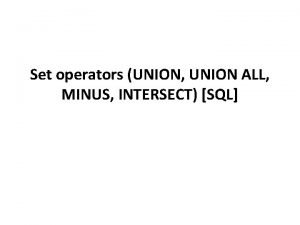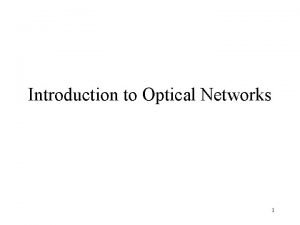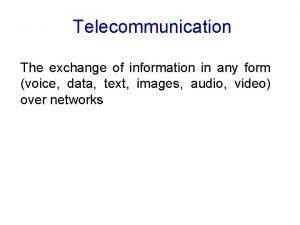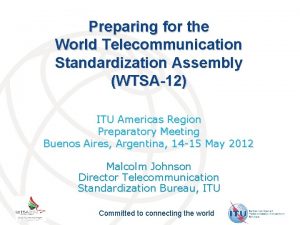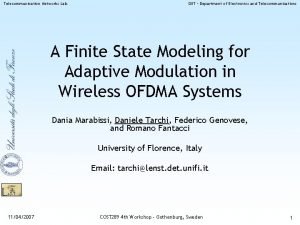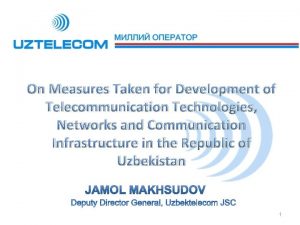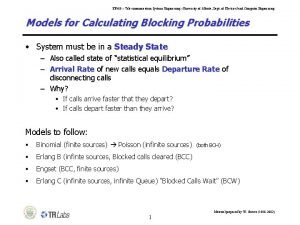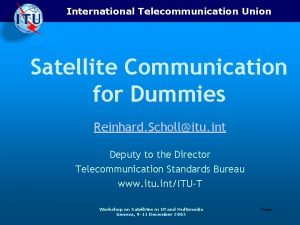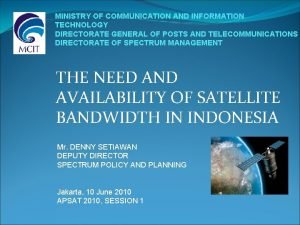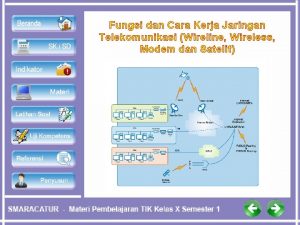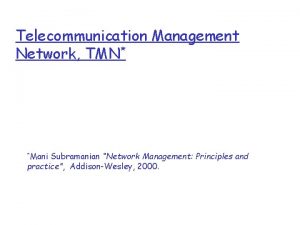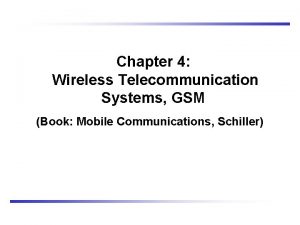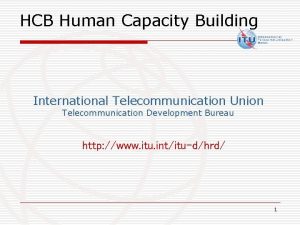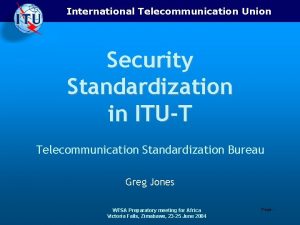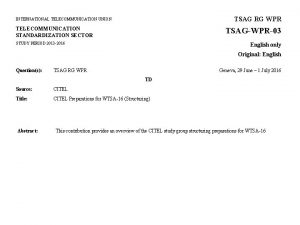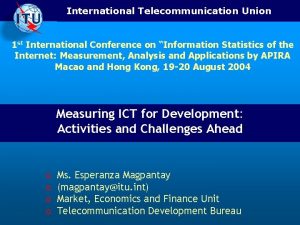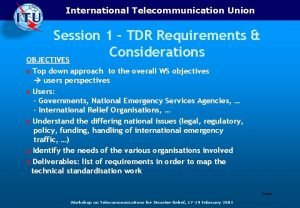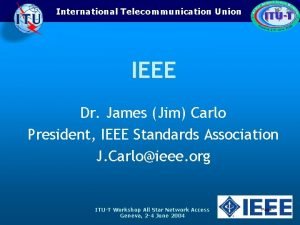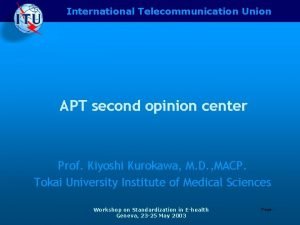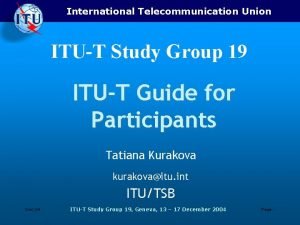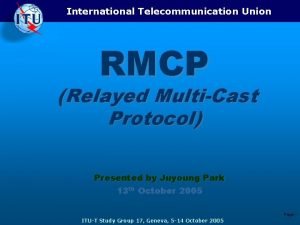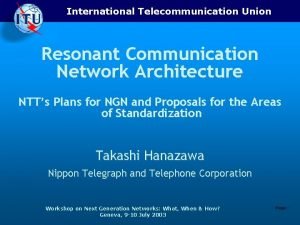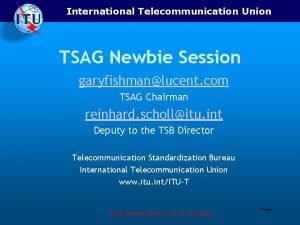International Telecommunication Union Improving IP Connectivity in the























- Slides: 23

International Telecommunication Union Improving IP Connectivity in the Least Developed Countries Background study Claudia Sarrocco Strategy and Policy Unit International Telecommunication Union 12 April 2002 The views expressed in this paper are those of the authors and do not necessarily reflect the opinions of 1 the ITU or its Membership. The author can contacted by e-mail at claudia. sarrocco@itu. int.

International Telecommunication Union Outline 12 April 2002 Introduction Background Vicious circle Conclusions: barriers What can we do? Proposal Virtuous circle 2

International Telecommunication Union Background Digital divide initiatives - DOT force - UN ICT task force “Improve connectivity, increase [ICT] access and lower cost” 12 April 2002 3

International Telecommunication Union Objective To provide low cost Internet connectivity to LDCs through the utilization of flexible, less expensive and simple technology, like VSATs, engendering a “virtuous circle” which can help reducing the digital divide among countries. 12 April 2002 4

International Telecommunication Union Scope: LDCs ü Forty-nine countries, with a total population of about 670 million inhabitants, are currently designated by the United Nations as “least developed countries" (LDCs). ü Cambodia, Gambia, Lao PDR, Mali, Mozambique, Nepal, Rwanda, Samoa and Uganda have been chosen as representative of the LDCs group and will be object of a deeper analysis. 12 April 2002 5

International Telecommunication Union Why Least Developed Countries? • In LDCs teledensity is 0. 59%, compared to 10% in developing countries In LDCs problems are more extreme than those of developing countries, and deserve special attention • There is less than one Internet user per one thousand people, against one user per 36 people in developing countries 12 April 2002 6

International Telecommunication Union Why focus on connectivity? ü Connectivity is the possibility for a user of an electronic network to communicate with other networks ü Connectivity is fundamental, as it precedes access to and use of the Internet ü LDCs have very low levels of connectivity … 12 April 2002 7

International Telecommunication Union International Internet Bandwidth… Source: Tele. Geography Inc. Data valid for September 2001 12 April 2002 …is not equally distributed 8

International Telecommunication Union LDCs are falling behind… World: 360 million LDCs: 0. 58 million 0. 13% 12 April 2002 Population Estimated Internet Users Total: 6 billion LDCs: 680 million 10% 9

International Telecommunication Union …and failing to catch up Thousands 700 444% 600 LDCs % growth 500 400 300 281% 234% 230% 167% 200 116% World % growth 56% 64% 57% 0 1995 12 April 2002 1996 1997 1998 1999 49% 2000 Internet users growth rate (56%) in LDCs is only a few points above average growth worldwide (49%) 10

International Telecommunication Union Low growth, high demand 80 International Traffic International Internet capacity 70 Bit-Minute Index 60 0. 5 50 40 30 0. 2 20 0. 2 0. 1 10 0. 1 0. 1 oa W es te rn Sa m ga nd a U an da w R ep N bi am oz M al e qu i al P. D M . R . a bi am G La o C am bo d ia 0 12 April 2002 Bit-minute Index: any amount under 1 indicates the 11 existence of latent demand for the Internet (selected countries)

International Telecommunication Union Infrastructure: Limited and Expensive Country 12 April 2002 Uplink/downlink capacity Population Proportionate cost per 64 Kbit/s (million) unit/month Lao PDR 1. 644/ 1. 244 Mbit/s 5. 23 n. a. Rwanda 1. 256/1. 5 Mbit/s 7. 73 n. a. Mali 2/3 Mbit/s Samoa 512/2. 256 Kbit/s Cambodia 3. 5/6 Mbit/s 13. 11 USD 625 Mozambique 1. 6/2. 2 Mbit/s 19. 68 n. a. Gambia 5/5 Mbit/s Nepal 5. 5/10 Mbit/s 23. 04 USD 625 Uganda 4/12 Mbit/s 23. 30 n. a. 11. 23 USD 1’ 500 0. 18 USD 840 1. 30 USD 625/265 12

International Telecommunication Union Result: High ISP costs for the end-user 12 April 2002 ISP charges (month) USD ISP charges (month) PPP 13

International Telecommunication Union This translates into a “ vicious circle” No exploitation of No growth of infrastrctures Economies of scale Low international Internet connectivity Low bargaining Power of ISPs Lack of competition Little investment in New infrastructures 12 April 2002 High connectivity Charges for ISPs Low demand for Internet services 14

International Telecommunication Union Conclusions: There are many barriers to Connectivity for LDCs ü Infrastructure: < High cost, low availability ü Restrictive regulation: < Monopoly of telecommunication sector < Only one provider imposing its tariffs < Limited competition on the end-user side (ISPs) 12 April 2002 ü Market Failure: < Small market < Operators cannot benefit from economies of scale < Operators do not have bargaining power to obtain more attractive prices < Latent demand is not satisfied 15

International Telecommunication Union What can we do? 12 April 2002 16

International Telecommunication Union The proposal 12 April 2002 ü Internationally-funded project ü Objective: to provide VSAT bandwidth to LDCs at low cost ü This bandwidth would be provided to ISPs 17

International Telecommunication Union Why target ISPs? - Allows not to bypass local market and local network (less regulatory problems) - ISPs are the most appropriate target for the project, as they already have technical knowledge and equipment to provide services. - Computer services shops and cybercafés could also be targeted. 12 April 2002 18

International Telecommunication Union The effect of improved connectivity: Catching up…? - Increased number of users - Drop in costs - Increased bandwidth 12 April 2002 19

International Telecommunication Union The financing: VSAT costs are still too high for LDCs - Internationally-funded Project structured over 5 -7 years, decreasing each year to support bandwidth provision 12 April 2002 - Financing allocated to ISPs through a competitive tendering process based on the reverse auction system (least cost subsidy): The winner will be the entity providing the service at given conditions with the smaller financing 20

International Telecommunication Union Summary: How will it work? 12 April 2002 ü Connectivity will be provided to ISPs in LDCs ü Partial funding: ISPs will participate in the financing ü In exchange for funding they will provide basic access at lower prices to private end-users, schools, etc. ü In addition, ISPs will be able to make commercial use of part of the bandwidth provided to offer enhanced services to business, foreign entities, etc. ü At the end of the 5 -7 years, with the growth of the user base, ISPs should be able to be completely self-financed, and provide Internet services on a fully commercial basis, at affordable cost. 21

International Telecommunication Union IP Connectivity Project: virtuous circle Higher international Internet connectivity New investment in infrastructures Market growth Bargaining power 12 April 2002 Economies of scale Market liberalization Lower costs Higher Demand For Internet services 22

International Telecommunication Union Thank you ! http: //www. itu. int/ipdc 12 April 2002 23
 Sql union minus intersect
Sql union minus intersect Iupap
Iupap International union of forest research organizations
International union of forest research organizations In a telecommunications network architecture, a protocol is
In a telecommunications network architecture, a protocol is Alcatel lucent
Alcatel lucent Telecommunication information
Telecommunication information World telecommunication standardization assembly
World telecommunication standardization assembly Itu world telecommunication indicators database
Itu world telecommunication indicators database Telecommunication network management lecture notes
Telecommunication network management lecture notes Cablaggio strutturato edifici
Cablaggio strutturato edifici Telecommunication
Telecommunication Telecommunication sealing technology
Telecommunication sealing technology Telecommunication sealing technology
Telecommunication sealing technology Telecommunication
Telecommunication Telecommunication for dummies
Telecommunication for dummies Ministry of telecommunication
Ministry of telecommunication Means of telecommunication
Means of telecommunication Gambar jaringan wireline
Gambar jaringan wireline Telecommunication system architecture with diagram
Telecommunication system architecture with diagram Telecommunication system architecture with diagram
Telecommunication system architecture with diagram Telecommunication
Telecommunication Tmn conceptual model
Tmn conceptual model Telecommunication systems book
Telecommunication systems book Risk management in telecommunication projects
Risk management in telecommunication projects
